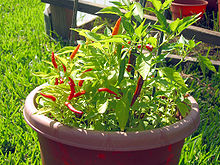Piri piri
This article needs additional citations for verification. (June 2011) |
| Piri piri | |
|---|---|
 Pili pili peppers (ripe red and unripe green) | |
| Genus | Capsicum |
| Species | Capsicum frutescens |
| Cultivar | Pili pili |
| Heat | |
| Scoville scale | 50,000–175,000[1] SHU |
Piri piri (/ˌpiːriˈpiːri/ PIR-ree-PIR-ree, also spelled peri peri, pili pili),[1] also called African bird's eye chili, is a cultivar of Capsicum frutescens, one of the sources of chili pepper that grows both wild and domesticated.
It is a small member of the Capsicum genus. It grows in Angola, Uganda, Malawi, South Africa, Ghana, Nigeria, Zambia, Zimbabwe, Mozambique, the tropical forests of South Sudan and the highlands of Ethiopia. It was brought to Goa, India by the Portuguese.
Etymology
Piri piri is the Swahili word for 'pepper pepper'.[2] Other Romanizations include pili pili in the Democratic Republic of the Congo or peri peri in Malawi, deriving from the various pronunciations of the word in parts of Bantu languages-speaking Africa. Piri piri is the spelling of the name as used in the Portuguese language, namely in the Portuguese-speaking Mozambican community.[2]
The Oxford Dictionary of English records piri-piri as a foreign word meaning "a very hot sauce made with red chilli peppers" and giving its origin as the Ronga language of southern Mozambique word for "pepper".[3]
Plant characteristics
Plants are usually very bushy and grow in height to 45–120 cm (18–47 in) with leaves 4–7 cm (1.6–2.8 in) long and 1.3–1.5 cm (0.51–0.59 in) wide. The fruits are generally tapered to a blunt point and measure up to 8–10 cm (3–4 in) long. Immature pod color is green, mature color is bright red or purple. Some varieties of birdseye measure up to 175,000 Scoville heat units.

Cultivation
Like all chili peppers, piri piri is descended from South American cultivars, but piri piri has grown in the wild in Africa for centuries and is now cultivated commercially in Zambia, Uganda, Malawi, and Zimbabwe.[4] It grows mainly in Malawi, Zambia, South Africa, Ghana, Nigeria, Zimbabwe and Mozambique.[1] It is cultivated for both commercial food processing and the pharmaceutical industry. Cultivation of piri piri is labor-intensive.[4]
Piri piri sauce

Piri piri sauce (used as a seasoning or marinade) is Portuguese in origin and "especially prevalent in Angola, Namibia, Mozambique and South Africa".[5] It is made from crushed chillies, citrus peel, onion, pepper, salt, lemon juice, bay leaves, paprika, pimiento, basil, oregano, and tarragon.[6]
Recipes vary from region to region but the common ingredients will be the chilli, lemon, oil and red bell peppers. Today it can be easily made in a blender[7] or by shaking the ingredients up in a jar.[dubious – discuss].[8]
See also
- Capsicum
- Capsicum frutescens
- List of Capsicum cultivars
- Malagueta pepper (Capsicum frutescens var. malagueta)
- Nando's
References
- ^ a b http://www.nandos.co.uk/story/index.html
- ^ Stevenson, Angus, ed. (2010). piri-piri, noun. Oxford University Press, Oxford Reference Online.
{{cite encyclopedia}}:|access-date=requires|url=(help);|work=ignored (help) - ^ a b "Fiery Foods and Barbecue SuperSite - Pepper Profile: African Birdseye". Fiery-foods.com. Retrieved 27 December 2011.
- ^ Rowley Leigh, "A Fiery Challenge for Delicate Palates", The Financial Times (London, England), 25 September 2004, p. 6.
- ^ David A. Bender, ed. (2009). "piri-piri". A Dictionary of Food and Nutrition. Oxford University Press. Retrieved 24 February 2013.
- ^ "Piri Piri Sauce Video".
- ^ "Homemade Piri-Piri Sauce | DJ BBQ" (video). youtube.
External links
- Pepper Profile: African Birdseye at www.fiery-foods.com
 Media related to Capsicum frutescens 'Piri Piri' at Wikimedia Commons
Media related to Capsicum frutescens 'Piri Piri' at Wikimedia Commons

